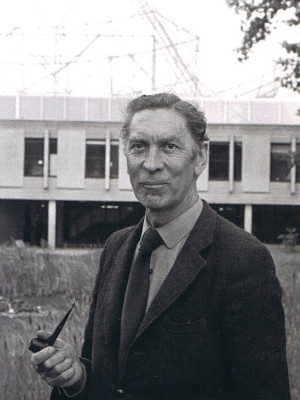 Roger Jennison in front of the building named after him (Photo courtesy of A. McNally)
Roger Jennison in front of the building named after him (Photo courtesy of A. McNally)
Roger Clifton Jennison
Contributed by Ralph Spencer
Roger Jennison was born in Grimsby, Lincolnshire, UK on 18 December 1922 and died in Canterbury, Kent, UK on 29 December 2006. He was educated at the Clee Grammar School for Boys, Grimsby. At the age of 18 he was a student of engineering at Hull Technical College and while acting as a firewatcher he was recommended for a bravery award for removing unexploded bombs from the technical college and the Children's Hospital in Hull in May 1941. He joined the Royal Air Force in November 1941 and left in 1947 to join the Physics Department at the University of Manchester as an undergraduate. On graduation he went on to do a PhD in the radio astronomy group at Jodrell Bank Experimental Station in 1950.
He completed his thesis in 1955 in Robert Hanbury Brown's interferometry group where he designed and constructed an intensity interferometer with Mrinal Das Gupta. The use of baselines up to 33 km with portable broadside arrays allowed the now famous 'double' structure of Cygnus A to be discovered. Further work in 1956 included three different frequencies (116.5, 123 and 132.7 MHz) and refined the visibility measurements. It was the first instance of multi-frequency synthesis. After his PhD he became a lecturer in Physics in Manchester and rebuilt the electronics of the interferometer to allow the transfer of a local oscillator signals via radio links for a 3-element correlation interferometer. His seminal 1958 work on 'closure phase' led to improved imaging techniques in the 1970's and now commonly used in radio astronomy.
In 1965 he became the first Professor of Physical Electronics at the University of Kent, Canterbury, encouraging work on Cosmic Dust, which later became a leading space science group under Tony McDonnel. He encouraged a small radio astronomy group (Les Little and Geoff Macdonald), specialising in spectral line work. He developed an interest in the relativity of rotating bodies and published several papers on fundamental physics. Under his charge the department grew, becoming the Electronic Engineering Laboratories and later the Department of Engineering and Digital Arts.
He was a very original thinker and not afraid of opposing established views. He was also a talented artist and a founder member of Canterbury Society of Art.
Modified on Friday, 24-Feb-2023 07:01:41 EST by Ellen Bouton, Archivist (Questions or feedback)
|
![[IAU logo]](iau_wb_thumb.jpg)
![[URSI logo]](URSI-logo-thumb.jpg)
![[Karl Jansky at his antenna]](jansky_photo_02_thumb.jpg)
![[Reber's Wheaton antenna]](Reber_Telescope_Wheaton_thumb.jpg)
![[Dover Heights]](Dover_Heights_02_thumb.jpg)
![[4C telescope]](GB61-195_4C_telescope_thumb.jpg)
![[Ewen and horn antenna]](ewen_horn1s.jpg)
![[Dwingeloo, 1956]](Dwingeloo-1956-thumb.jpg)
![[Jocelyn Bell Burnell and Cambridge antenna used in pulsar discovery]](burnell2_thumb.jpg)
![[Lovell Telescope at Jodrell Bank]](site_1594_0001-500-334-20180316163019-thumb150.jpg)
![[Wilson, Penzias, and Bell Labs horn antenna]](wilson-penzias-horn_thumb.jpg)
![[6-m Millimeter Radio Telescope in Mitaka, Japan]](6m-thumb.jpg)

